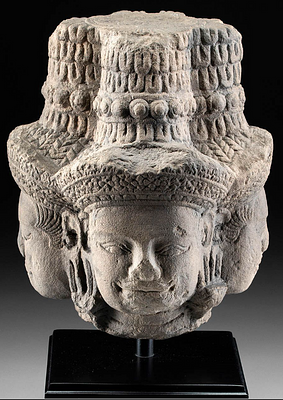19th C. European Oval Mirror w/ Gilt Frame
Lot 132a
About Seller
Artemis Gallery
686 S Taylor Ave, Ste 106
Louisville, CO 80027
United States
Selling antiquities, ancient and ethnographic art online since 1993, Artemis Gallery specializes in Classical Antiquities (Egyptian, Greek, Roman, Near Eastern), Asian, Pre-Columbian, African / Tribal / Oceanographic art. Our extensive inventory includes pottery, stone, metal, wood, glass and textil...Read more
Categories
Estimate:
$2,400 - $3,600
Absentee vs Live bid
Two ways to bid:
- Leave a max absentee bid and the platform will bid on your behalf up to your maximum bid during the live auction.
- Bid live during the auction and your bids will be submitted real-time to the auctioneer.
Bid Increments
| Price | Bid Increment |
|---|---|
| $0 | $25 |
| $300 | $50 |
| $1,000 | $100 |
| $2,000 | $250 |
| $5,000 | $500 |
| $10,000 | $1,000 |
| $20,000 | $2,500 |
| $50,000 | $5,000 |
| $100,000 | $10,000 |
| $200,000 | $20,000 |
About Auction
By Artemis Gallery
Jun 29, 2023
Set Reminder
2023-06-29 10:00:00
2023-06-29 10:00:00
America/New_York
Bidsquare
Bidsquare : Exceptional Antiquities, Ethnographic and Fine Art
https://www.bidsquare.com/auctions/artemis-gallery/exceptional-antiquities-ethnographic-and-fine-art-13031
Artemis Gallery info@artemisgallery.com
Artemis Gallery info@artemisgallery.com
- Lot Description
European, late 19th to early 20th century. A grand-scale oval wall mirror housed in an elaborately carved and gilded wooden frame. The frame is adorned with an attractive beaded rope motif and culminates with intricately detailed crests embellished by floral and foliate motifs. The gilding has been tested via x-ray fluorescence and contains as much as 45% to 58.6% gold. Luxurious mirrors like this were regarded as valuable possessions and passed down as treasured heirlooms from generation to generation. Size: 36" L x 41.75" W (91.4 cm x 106 cm)
The word mirror derives from the French word "mirour," which comes from the Latin term "mirari" and literally means "to admire" and was likely influenced by the ancient Romans word "speculum" which derived from "specere" meaning to behold or look. According to the Jaukowsky Institute for Archaeology & the Ancient World, "Reflective surfaces made of polished obsidian are the oldest 'mirrors' in the archaeological record, dating back as far as 4000 BCE. The first evidence of mirrors as grooming tools dates to the 5th century BCE, in illustrations of elegant Greeks gazing at hand mirrors (these illustrations are found on antique pottery). These mirrors, made from a polished metal disk attached to a handle, did not contain any glass. The first real glass mirrors in the record are from the 3rd century AD, consisting of extremely small (a few square inches) concave or convex metal surfaces with glass coatings. The size and style of these early mirrors leads many archaeologists to believe that they were used as jewelry or amulets rather than for personal grooming (Sabione Melchoir-Bonnet - "The Mirror: A History" p. 12)."
During the 13th to 15th centuries, glassblowing techniques had advanced, particularly in Venice, Italy, and Venice became the epicenter for the mirror industry for hundreds of years exporting mirrors to bourgeois clientele as well as royalty in the late 16th through the 17th centuries. According to Melchior-bonnet, Venetian mirrors were oftentimes more valuable than paintings from High Renaissance artists.
In France, Louis XIV issued a decree in 1689 that all private silver was to be confiscated in order to melt into coins used to pay for military campaigns. Since the wealthy had to forego all of their luxury items made of precious metals, mirrors became their prized possessions. Perhaps the most famous mirrors were created for King Louis XVI himself, the legendary Sun King. His famous Hall of Mirrors at Versailles were designed by Jules Hardouin-Mansart (1646-1708) and boasted an impressive 17 mirrored arches comprised of 357 mirrors reflecting views from the 17 windows on the opposite side of the hall. The fact that mirrors amplified lighting and provided the illusion of an extension of space aligned with an artistic focus on light and optics in Europe during the 17th and 18th centuries.
Provenance: private Greenwood Village, Colorado, USA collection
All items legal to buy/sell under U.S. Statute covering cultural patrimony Code 2600, CHAPTER 14, and are guaranteed to be as described or your money back.
A Certificate of Authenticity will accompany all winning bids.
We ship worldwide and handle all shipping in-house for your convenience.
#178726Glass is intact. Frame shows expected age wear with scuffs and fissures/cracks to areas as shown. There are some repairs to the decorative crests at the top and bottom of the frame. The gilding has been tested via x-ray fluorescence and contains as much as 45% to 58.6% gold. The board attached to the verso of the mirror has some stains and abrasions as well as the remains of an old label inscribed "M. Br" in black ink. In addition to an old iron suspension loop, there is a newer suspension wire on the verso.Condition
- Shipping Info
-
All shipping is handled in-house for your convenience. Your invoice from Artemis Gallery will include shipping calculation instructions. If in doubt, please inquire BEFORE bidding for estimated shipping costs for individual items.
-
- Buyer's Premium



 EUR
EUR CAD
CAD AUD
AUD GBP
GBP MXN
MXN HKD
HKD CNY
CNY MYR
MYR SEK
SEK SGD
SGD CHF
CHF THB
THB















